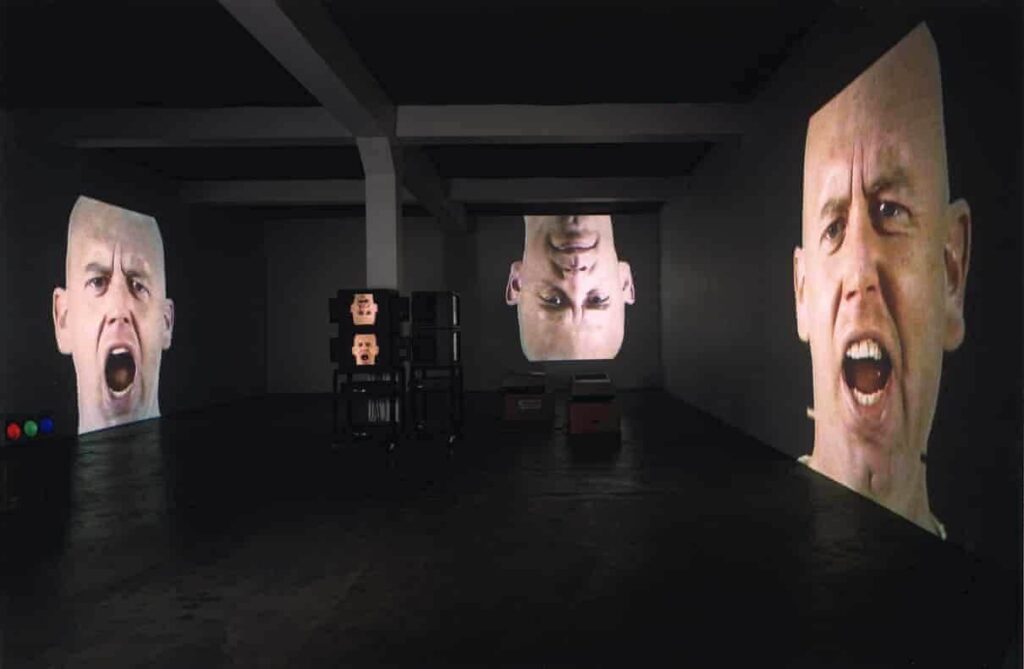
Installation View Of Feed Me/Anthro-Socio, Bruce Nauman, 1993, The Guardian Source: https://www.thecollector.com/bruce-nauman/
On the 21 of February Tate Modern’s major exhibit on Bruce Nauman closed, and due to the Covid-19 pandemic, very few people, myself included, got the opportunity to see the pieces which were included in the show. This is unfortunate in part because this was the first major London exhibit of Nauman’s work in around 20 years and, if history repeats itself, it seems unlikely that there will be another retrospective any time soon. More so it is unfortunate that many people will miss out on the wonderfully inventive, challenging and somehow very often hilarious universe of Bruce Nauman.
I have had the fortune of seeing a few pieces by Nauman over the years and I have always been struck by both their bizarreness and uniqueness. Nobody seems to make art work quite like him. On the other hand I’m aware of my own bias attitude and that Nauman’s work is often polarizing. For every person who considers him brilliant another views him as pretentious, for every laugh there is an equal amount of eye rolls and yawns. I think this polarising nature in part is because Nauman’s pieces are often not beautiful. In fact he ignores ideas of traditional beauty going so far as to say that the very notion of ‘having an idea of what it is to be beautiful’ shoehorns the artist into making a particular type of work.
It is true that much of contemporary art has been criticised along these lines (see the comments on almost any YouTube video concerning a contemporary artist), however very few push it to the extreme as Nauman does. With the exception of perhaps Paul McCarthy, almost no artist creates work which is genuinely difficult to look at. Take for instance Nauman’s work ‘Clown Torture’ (1987) in which four videos of clowns envelop a room with a cacophony of screams.
Described this way I admit the pieces, let alone an entire retrospective, do not seem appealing and this is one of the fundamental problems with Nauman’s work; it is hard to talk about. Descriptions often become vague and fail to capture what I think is brilliant about them. ‘Seven Figures’ has been described, not just by myself, but also by Peter Plagens, as being a great piece of slapstick art (Tate Shots, 2017), however describing it doesn’t really convey the humour. It is akin to telling a rude joke having forgotten the punchline – you might follow the narrative but fail to arrive at the “ha ha” moment. This is deliberate. One of the defining themes of Nauman is an exploration of the ambiguous nature of language, a probing of the point at which communicable discourse simply breaks apart and words become sounds instead of language.
In many of his video installations like ‘Anthro/Socio (Rinde Spinning)’ (1992) words cease to be discernible as means of communication and instead, through both repetition and volume, become simply noise utterances. Nauman explores how if you twist the use of words you can turn sense into nonsense. His art employs Wittgensteinian linguistics in a kind of stress test, seeing how far we can go until the word/meaning relationship simply breaks.
This notion of breakdown, or what Nauman calls going to the “spot” (Art21) is investigated beyond its relation to language. By exploring how meaning is constructed and then breaking down the rules that govern that construction (be it construction of the body, language, gender or sex) Nauman forces us to see the world as a set of accidental regularities and how much of a false start our attempt at producing meaning can be.
I would urge people to not just take Nauman seriously (I resist the view that he is just a shock artist) but implore people to seek out his pieces. I mentioned at the start the sense of uniqueness, of radical otherness, being a defining aspect of who Nauman is as an artist. Take the following example, in the late 1960’s to early 70’s American art was predominantly filled with the severe works of minimalists. Nauman meanwhile was creating photographs where he squished and contorted his mouth (see ‘a’ (1970)) alongside ‘Green Light Corridor’ (1970); an extremely thin corridor illuminated with green lights and in which the audience becomes intensely (almost uncomfortably) aware of their own position in space-allowing the participant to feel what Nauman was doing with early video pieces like Wall Floor Positions (1968).
I hope that galleries in the UK stage another retrospective. Whether you end up loving him or hating him, Nauman’s work is ridiculously influential, The New York Times argued for instance that “one would have to look to Andy Warhol to find a figure who cast such a long shadow over the cultural landscape” (Nikil Saval, 2018). This much is true but he is often seen as being an artist’s artist. Hopefully this will change and more people will have the chance to enter the strange, demanding, and hilarious mind of Bruce Nauman.
Filed under: Art & Photography
Tagged with: american, art, artist, Bruce Nauman, contemporary, controversial, Culture, divisive, film, retrospective, video



Comments